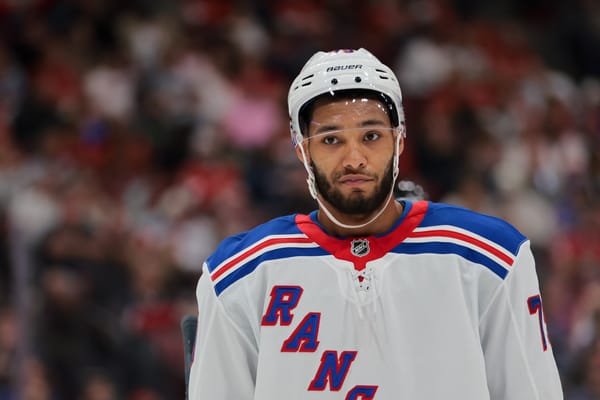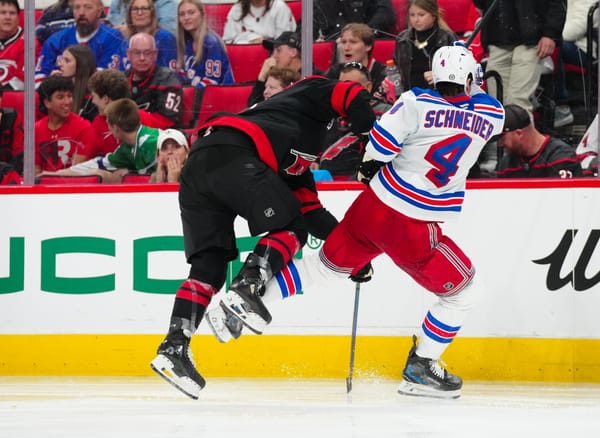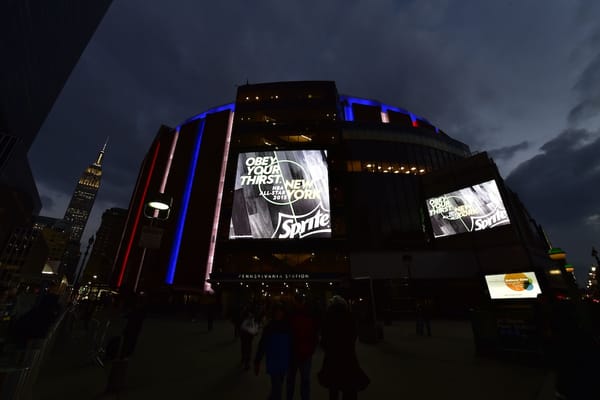Analyzing The Lias Andersson And Filip Chytil Selections
The New York Rangers hadn’t had a first round pick in five years. Then this year they had two in the top 21 selections.
When all was said and done initially I felt like this:
All I'll say is I'm not sure the direction Gorton is moving. Expected a different approach. Went too safe with 7 and very risky with 21
— Joe Fortunato (@BlueshirtBanter) June 24, 2017
Then, after a little more research, I felt like this:
NYR's strategy tonight has grown on me a lot, actually.
— Joe Fortunato (@BlueshirtBanter) June 24, 2017
Here’s why the change in heart:
Lias Andersson
With the 7th overall selection there was bound to be a lot of good prospects on the board ... and there were! The Rangers were looking at names like Gabriel Vilardi, Nicholas Suzuki, Tomothy Liljegren, and Casey Mittelstadt. They played it in the fairway however (read: made the safe pick) and selected Lias Andersson.
There was, of course, instant outrage that the player individual fans wanted wasn’t selected, but there was a logical amount of uncertainty around the pick on the surface. Andersson was ranked anywhere from 12th to the high teens in most draft rankings. In fact, most mock drafts had Andersson going around 15th.
Now, it’s not the biggest deal in the world to reach a few picks for a guy you really like. But in a draft where it seemed like moving down was preferable to moving up, and with the Rangers being devoid of a second and third round pick this year? Yeah, moving from 7th to 14th or 15th in order to earn an extra second round pick might have been smarter.
Right after his selection, however, it was rumored the Los Angeles Kings (sitting at 11) were hot and heavy for Andersson, and the Rangers obviously weren’t sure they’d be able to fall back and still have him around, so they grabbed him at 7th.
I can tell you with relative certainty that the first round played out in a way that led to this move. The Rangers were very interested in Elias Pettersson, but he was taken 6th by Vancouver. Cale Makar was one of their highest rated defenseman and he was taken 4th overall. When your top of the card players are being selected, it changes the strategy a little.
Also, for as much as Andersson is a “safe” pick, he’s not a bad pick. To this point:
To be clear, this pick is not McIlrath 2.0. The disappointment comes from not maximizing 7th overall. Andersson is a good prospect. https://t.co/6AfA48OUVf
— Adam Herman (@AdamZHerman) June 24, 2017
Actually, he’s one of the more polished prospects in this pool of players. Andersson has played the past two years of his career in the SHL. He spent the entire season there last year (as an 18-year-old) and notched 19 points in 42 games — with a huge surge in the second half/playoffs that actually caught the Rangers’ eye. The year before (at 17) Andersson didn’t record a single point in 22 SHL games (not totally uncommon) but blew the doors off of the SuperElit (a lesser SHL league) with 59 points in 37 games. Internationally he scored three goals in seven WJC games last year (again, as an 18-year-old in an U20 tournament) and had 15 points in 17 total U20 games for Sweden.
He’s got a knack for being in the right spot at the right time, isn’t afraid of contact, and is always around the net. He has slick hands and a very high hockey IQ. I hate the terms “hockey IQ” without backing it up so here’s what I mean by that: He finds the soft spaces on the ice regularly and when there’s holes in front of the net or in dangerous areas he finds them. His quick hands allow him to find all types of goals around the net -- even when he’s bull-rushing himself to the front of it -- and he has a sneaky good snipe from the outside. He’s also a little underrated, I would say, passing the puck. How his passing transitions onto the smaller ice surface in the NHL remains to be seen, but by the look of some of the below goals, the kid isn’t going to have an issue in front of NHL nets.
I put together some of Lias Andersson's goals from the 2016/17 season. #NYR pic.twitter.com/N0FH1x6es1
— Alex Nunn (@aj_ranger) June 24, 2017
Offensive ability aside, Andersson is very stable in his own end. He’s a quality two-way player, already, and there’s surely more learning to come on that front with another year of development in the SHL.
After the pick I reached out to a plethora of draft experts who all raved about his two-way game. While most agree Andersson probably will not be the best player on your team, many think he’s a sure-fire top-six player at the very least. Some even think Andersson could make a real case at sticking in the NHL this season. Not that it’s expected, but that’s how polished the SHL has made his game.
Were there players with potentially higher upside the Rangers could have taken with this pick? Absolutely. Were those players far riskier? Absolutely. But with the team’s first top-10 pick in seemingly forever, I don’t hate the idea of grabbing a “sure thing” (if there can be one) top-six guy who might turn into a top-line guy.
Filip Chytil
When the Rangers came up at 21 it seemed like a dream scenario. Unlike at 7th when the Rangers top players on the board were already selected, at 21st there were a few players highly linked to the Rangers on the board. Most notably Kailer Yamamoto, Eeli Tolvanen, and Klim Kostin (the last two somehow fell to the final two picks in the 1st round).
The Rangers went totally off the board at 21, though, and picked Filip Chytil -- a player who elicited “who the hell is that” among fans.
On the surface, the Rangers reversed what they should have done with these two picks. They went too safe with the 7th overall pick and too risky with the 21st. Chytil, I will admit, was a player I had very limited knowledge of coming into the draft. I did a ton of research last night after the pick, though, and I think I love this selection.
For starters: If the Rangers didn’t have the 7th overall selection, I don’t think they ever go down this road. There was a very clear strategy to go safe with the 7th because of the risk they were going to take with the 21st, and they had to know that Chytil would be available at 21.
Chytil’s rankings are far more sporadic than Andersson’s were. Chytil was ranked 28th by Hockey Prospect, 31st by TSN/McKenzie, and 11th (EU skaters only) by NHL Central Scouting. Some respected rankings had him as high as 70th overall.
Before you panic, though, here’s what so special about this pick: Chytil was 10 days away from being a 2018 draft eligible player where, most scouts seem to agree, he’d probably start among the top-10 picks in early mocks. Unlike Ryan Gropp — who missed the cutoff of an earlier draft by 24 hours and was the oldest guy of his class — Chytil is the youngest. He’s 17, and won’t turn 18 until September.
As a 17-year-old, he played 38 games in HC Zlin in the Czech Extraliga, one of Europe’s top four professional leagues. At 17, he notched eight points in those 38 games against men. Think about that for a moment. Look at some of his production despite his age in the Czech circuit of leagues:
As a 15-year-old: Chytil recorded 30 goals and 18 assists for 48 points in 25 HC Zlin U16 games. He was so dominant that he was moved to the U18 level where he notched nine points in 19 games.
As a 16-year-old: Chytil scored 28 goals and added 22 assists for 50 points in 30 HC Zlin U18 games. That year he also notched seven points in 20 U17 international games.
As a 17-year-old: You know about the 8 points in 38 HC Zlin games (again, against men). What you don’t know is that in their playoff series (to avoid relegation, which they did) he had a goal and an assist in two games. He also recorded five points for Czech in as man WJC-U18 games and 13 points in 19 U18 Czech games (total competitions).
Here’s a positively glowing review from Canucks Army about how much of a steal Chytil might be. Read that article, but I’ve taken an excerpt out here for you as well comparing him to 12th overall selection this year Martin Necas (who is eight months older):
Statistically speaking, he shows better than his eight points would indicate on the surface. Chytil received an average of 12:30 of ice time in his 38 Extraliga games, with about 6% of that coming on the power play (an average of 46 seconds per game). The major difference between Chytil and Martin Necas, a projected top ten pick who also played in the Czech league is their power play ice time and production. Necas averaged 2:32 on the power play and scored five power play points – Chytil on the other hand did not have any power play points in his limited time on the man advantage.
Here’s some fun highlights of him:
If you’re going to gamble on a player, this is the type of player to do it with. After speaking to a few people in the know, Chytil probably slipped off most rankings simply because he was young enough that he wasn’t putting up monster stats. That’s not to say there’s no risk here -- there’s plenty of it — but there’s an upside as well that’s as high as you can try to see.
To be as young as he is, and playing in a men’s league speaks volumes. That he will have another full year to develop and by then will be alongside 2018 draft eligible players next year says even more.





